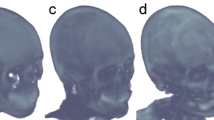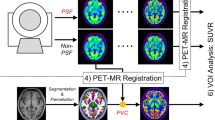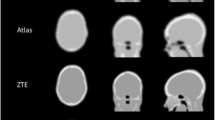Abstract
Purpose
In dual modality positron emission tomography (PET)/magnetic resonance imaging (MRI), attenuation correction (AC) methods are continually improving. Although a new AC can sometimes be generated from existing MR data, its application requires a new reconstruction. We evaluate an approximate 2D projection method that allows offline image-based reprocessing.
Procedure
2-Deoxy-2-[18F]fluoro-d-glucose ([18F]FDG) brain scans were acquired (Siemens HR+) for six subjects. Attenuation data were obtained using the scanner’s transmission source (SAC). Additional scanning was performed on a Siemens mMR including production of a Dixon-based MR AC (MRAC). The MRAC was imported to the HR+ and the PET data were reconstructed twice: once using native SAC (ground truth); once using the imported MRAC (imperfect AC). The re-projection method was implemented as follows. The MRAC PET was forward projected to approximately reproduce attenuation-corrected sinograms. The SAC and MRAC images were forward projected and converted to attenuation-correction factors (ACFs). The MRAC ACFs were removed from the MRAC PET sinograms by division; the SAC ACFs were applied by multiplication. The regenerated sinograms were reconstructed by filtered back projection to produce images (SUBAC PET) in which SAC has been substituted for MRAC. Ideally SUBAC PET should match SAC PET. Via coregistered T1 images, FreeSurfer (FS; MGH, Boston) was used to define a set of cortical gray matter regions of interest. Regional activity concentrations were extracted for SAC PET, MRAC PET, and SUBAC PET.
Results
SUBAC PET showed substantially smaller root mean square error than MRAC PET with averaged values of 1.5 % versus 8.1 %.
Conclusions
Re-projection is a viable image-based method for the application of an alternate attenuation correction in neuroimaging.





Similar content being viewed by others
References
Ladefoged CN, Law I, Anazodo U, St. Lawrence K, Izquierdo-Garcia D, Catana C, Burgos N, Cardoso MJ, Ourselin S, Hutton B, Mérida I, Costes N, Hammers A, Benoit D, Holm S, Juttukonda M, An H, Cabello J, Lukas M, Nekolla S, Ziegler S, Fenchel M, Jakoby B, Casey ME, Benzinger T, Højgaard L, Hansen AE, Andersen FL (2017) A multi-centre evaluation of eleven clinically feasible brain PET/MRI attenuation correction techniques using a large cohort of patients. NeuroImage 147:346–359. https://doi.org/10.1016/j.neuroimage.2016.12.010
Hofmann M, Pichler B, Schoelkopf B, Beyer T (2009) Towards quantitative PET/MRI: a review of MR-based attenuation correction techniques. Eur J Nucl Med Mol Imaging 36(S1):93–104. https://doi.org/10.1007/s00259-008-1007-7
Catana C, van der Kouwe A, Benner T, Michel CJ, Hamm M, Fenchel M, Fischl B, Rosen B, Schmand M, Sorensen AG (2010) Toward implementing an MRI-based PET attenuation-correction method for neurologic studies on the MR-PET brain prototype. J Nucl Med 51(9):1431–1438. https://doi.org/10.2967/jnumed.109.069112
Keereman V, Fierens Y, Broux T, de Deene Y, Lonneux M, Vandenberghe S (2010) MRI-based attenuation correction for PET/MRI using ultrashort echo time sequences. J Nucl Med 51(5):812–818. https://doi.org/10.2967/jnumed.109.065425
Hofmann M, Bezrukov I, Mantlik F, Aschoff P, Steinke F, Beyer T, Pichler BJ, Scholkopf B (2011) MRI-based attenuation correction for whole-body PET/MRI: quantitative evaluation of segmentation- and atlas-based methods. J Nucl Med 52(9):1392–1399. https://doi.org/10.2967/jnumed.110.078949
Bezrukov I, Mantlik F, Schmidt H, Schölkopf B, Pichler BJ (2013) MR-based PET attenuation correction for PET/MR imaging. Sem Nucl Med 43(1):45–59. https://doi.org/10.1053/j.semnuclmed.2012.08.002
Khateri P, Rad HS, Fathi A, Ay MR (2013) Generation of attenuation map for MR-based attenuation correction of PET data in the head area employing 3D short echo time MR imaging. Nuclear Instruments Methods in Physics Research Section A: Accelerators Spectrometers Detectors and Associated Equipment 702:133–136. https://doi.org/10.1016/j.nima.2012.08.035
Santos Ribeiro A, Kops ER, Herzog H, Almeida P (2013) Skull segmentation of UTE MR images by probabilistic neural network for attenuation correction in PET/MR. Nuclear Instruments & Methods in Physics Research Section A: Accelerators Spectrometers Detectors and Associated Equipment 702:114–116. https://doi.org/10.1016/j.nima.2012.09.005
Wagenknecht G, Kaiser H-J, Mottaghy FM, Herzog H (2013) MRI for attenuation correction in PET: methods and challenges. Magn Reson mater Phy. Biol Med 26:99–113
Izquierdo-Garcia D, Hansen AE, Forster S, Benoit D, Schachoff S, Furst S, Chen KT, Chonde DB, Catana C (2014) An SPM8-based approach for attenuation correction combining segmentation and nonrigid template formation: application to simultaneous PET/MR brain imaging. J Nucl Med 55(11):1825–1830. https://doi.org/10.2967/jnumed.113.136341
Paulus DH, Quick HH, Geppert C, Fenchel M, Zhan Y, Hermosillo G, Faul D, Boada F, Friedman KP, Koesters T (2015) Whole-body PET/MR imaging: quantitative evaluation of a novel model-based MR attenuation correction method including bone. J Nucl Med 56(7):1061–1066. https://doi.org/10.2967/jnumed.115.156000
Natterer F (1983) Compterized-tomography with unknown sources. SIAM J Appl Math 43(5):1201–1212. https://doi.org/10.1137/0143079
Anastasio MA, Pan XC, Clarkson E (2001) Comments on the filtered backprojection algorithm, range conditions, and the pseudoinverse solution. IEEE Trans Med Imaging 20(6):539–542. https://doi.org/10.1109/42.929620
Dixon WT (1984) Simple proton spectroscopic imaging. Radiology 153(1):189–194. https://doi.org/10.1148/radiology.153.1.6089263
Martinez-Moller A, Souvatzoglou M, Delso G, Bundschuh RA, Chefd'hotel C, Ziegler SI, Navab N, Schwaiger M, Nekolla SG (2009) Tissue classification as a potential approach for attenuation correction in whole-body PET/MRI: evaluation with PET/CT data. J Nucl Med 50(4):520–526. https://doi.org/10.2967/jnumed.108.054726
Andersen FL, Ladefoged CN, Beyer T, Keller SH, Hansen AE, Højgaard L, Kjær A, Law I, Holm S (2014) Combined PET/MR imaging in neurology: MR-based attenuation correction implies a strong spatial bias when ignoring bone. NeuroImage 84:206–216. https://doi.org/10.1016/j.neuroimage.2013.08.042
Laymon C, Carney J, Davis D et al (2014) Comparison of MR-based with 511-keV transmission-based attenuation correction in neuro FDG PET/MR. J Nucl Med 55:2098
Defrise M, Kinahan PE, Townsend DW, Michel C, Sibomana M, Newport DF (1997) Exact and approximate rebinning algorithms for 3-D PET data. IEEE Trans Med Imaging 16(2):145–158. https://doi.org/10.1109/42.563660
Stark H, Woods JW, Paul I, Hingorani R (1981) Direct Fourier reconstruction in computer tomography. IEEE Trans Acoust Speech 29(2):237–245. https://doi.org/10.1109/TASSP.1981.1163528
Hudson HM, Larkin RS (1994) Accelerated image reconstruction using ordered subsets of projection data. IEEE Trans Med Imaging 13(4):601–609. https://doi.org/10.1109/42.363108
Shepp LA, Vardi Y (1982) Maximum likelihood reconstruction for emission tomography. IEEE Trans Med Imaging 1:113–122.. Ed. Grangeat P, Amans J-L. Springer, pp 255–268
Thielemans K, Asma E, Manjeshwar RM, et al. (2008) Image-based correction for mismatched attenuation in PET images [abstract]. 5292-5296P
Acknowledgements
This work was supported by NIH grants R21 EB002622 and P30 CA047904 and by an internal UPP Foundation grant. Subject data for this project were acquired through programs funded by NIH grants 5PO1AG025204 and NIA-P50-AG005133. We thank Drs. William Klunk and Oscar Lopez for providing data and assistance with subject recruitment. We thank James Ruszkiewicz and Denise Ratica for their assistance in acquiring and processing data.
Author information
Authors and Affiliations
Corresponding author
Ethics declarations
Conflict of Interest
The authors declare that they have no conflict of interest.
Rights and permissions
About this article
Cite this article
Laymon, C.M., Minhas, D.S., Becker, C.R. et al. Image-Based 2D Re-Projection for Attenuation Substitution in PET Neuroimaging. Mol Imaging Biol 20, 826–834 (2018). https://doi.org/10.1007/s11307-018-1171-5
Published:
Issue Date:
DOI: https://doi.org/10.1007/s11307-018-1171-5




